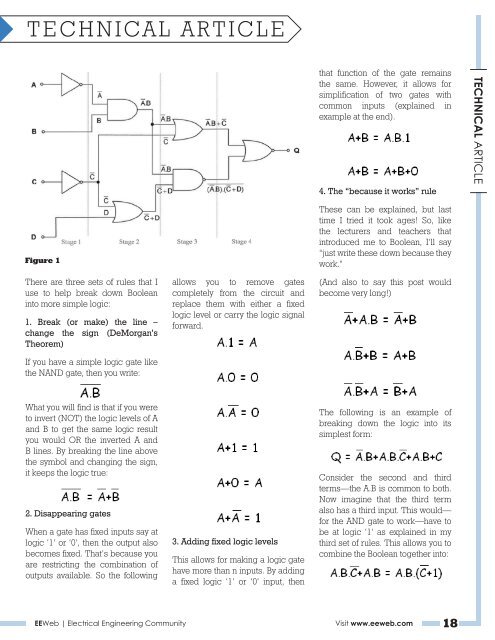Anthony Catalano - EEWeb
Anthony Catalano - EEWeb
Anthony Catalano - EEWeb
You also want an ePaper? Increase the reach of your titles
YUMPU automatically turns print PDFs into web optimized ePapers that Google loves.
TECHNICAL ARTICLE<br />
Figure 1<br />
There are three sets of rules that I<br />
use to help break down Boolean<br />
into more simple logic:<br />
1. Break (or make) the line –<br />
change the sign (DeMorgan’s<br />
Theorem)<br />
If you have a simple logic gate like<br />
the NAND gate, then you write:<br />
What you will find is that if you were<br />
to invert (NOT) the logic levels of A<br />
and B to get the same logic result<br />
you would OR the inverted A and<br />
B lines. By breaking the line above<br />
the symbol and changing the sign,<br />
it keeps the logic true:<br />
2. Disappearing gates<br />
When a gate has fixed inputs say at<br />
logic ‘1’ or ‘0’, then the output also<br />
becomes fixed. That’s because you<br />
are restricting the combination of<br />
outputs available. So the following<br />
allows you to remove gates<br />
completely from the circuit and<br />
replace them with either a fixed<br />
logic level or carry the logic signal<br />
forward.<br />
3. Adding fixed logic levels<br />
This allows for making a logic gate<br />
have more than n inputs. By adding<br />
a fixed logic ‘1’ or ‘0’ input, then<br />
that function of the gate remains<br />
the same. However, it allows for<br />
simplification of two gates with<br />
common inputs (explained in<br />
example at the end).<br />
4. The “because it works” rule<br />
These can be explained, but last<br />
time I tried it took ages! So, like<br />
the lecturers and teachers that<br />
introduced me to Boolean, I’ll say<br />
“just write these down because they<br />
work.”<br />
(And also to say this post would<br />
become very long!)<br />
The following is an example of<br />
breaking down the logic into its<br />
simplest form:<br />
Consider the second and third<br />
terms—the A.B is common to both.<br />
Now imagine that the third term<br />
also has a third input. This would—<br />
for the AND gate to work—have to<br />
be at logic ‘1’ as explained in my<br />
third set of rules. This allows you to<br />
combine the Boolean together into:<br />
<strong>EEWeb</strong> | Electrical Engineering Community Visit www.eeweb.com 18<br />
TECHNICAL ARTICLE















